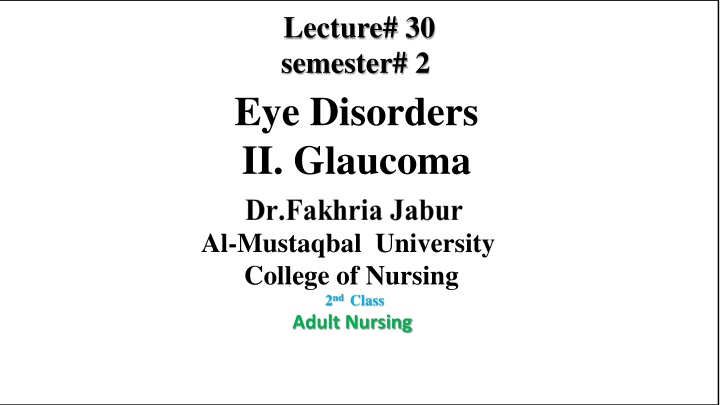
Glaucoma: Types, Risk Factors, and Pathophysiology
Learn about glaucoma, a group of ocular conditions characterized by elevated intraocular pressure (IOP) that damages the optic nerve. Discover the risk factors, classification, and theories on how increased IOP leads to optic nerve damage in glaucoma. Explore the physiology of aqueous humor flow and how to manage this condition effectively.
Download Presentation

Please find below an Image/Link to download the presentation.
The content on the website is provided AS IS for your information and personal use only. It may not be sold, licensed, or shared on other websites without obtaining consent from the author. If you encounter any issues during the download, it is possible that the publisher has removed the file from their server.
You are allowed to download the files provided on this website for personal or commercial use, subject to the condition that they are used lawfully. All files are the property of their respective owners.
The content on the website is provided AS IS for your information and personal use only. It may not be sold, licensed, or shared on other websites without obtaining consent from the author.
E N D
Presentation Transcript
Lecture# 30 semester# 2 Eye Disorders II. Glaucoma Al-Mustaqbal University College of Nursing 2nd Class Adult Nursing
glaucoma Glaucoma is a group of ocular conditions characterized by elevated IOP. The increased IOP damages the optic nerve and nerve fiber layer. The normal IOP is between 10 and 21 mmHg. The optic nerve damage is related to the IOP caused by congestion of aqueous humor in the eye. Is the 2ndleading cause of blindness in adult in the US. Glaucoma is more prevalent in people older than 40 years. There is no cure for glaucoma, but the disease can be controlled A. Normally, aqueous humor, which is secreted inthe posterior chamber, gains access to the anterior chamber byflowing through the pupil. In the angle of the anterior chamber, itpasses through the canal of Schlemm into the venous system.
Physiology Aqueous humor flows between the iris and the lens, nourishing the cornea and lens. Most (90%) of the fluid then flows out of the anterior chamber, draining through the spongy trabecular meshwork into the canal of Schlemm and the episcleral veins. About 10% of the aqueous fluid exits through the ciliary body into the suprachoroidal space and then drains into the venous circulation of the ciliary body, choroid, and sclera. Unimpeded outflow of aqueous fluid depends on an intact drainage system and an open angle (about 45 degrees) between the iris and the cornea. A narrower angle places the iris closer to the trabecular meshwork, diminishing the angle. The amount of aqueous humor produced tends to decrease with age, in systemic diseases such as diabetes, and in ocular inflammatory conditions.
Pathophysiology There are 2 theories regarding how increase IOP damage the optic nerve in glaucoma. The direct mechanical theory suggested : High IOP damages the retinal layer as it passes through the optic nerve head. The indirect ischemic theory suggested that high IOP compresses the microcirculation in the optic nerve head, resulting in cell injury and death.
RISK Factors of Glaucoma Cardiovascular disease Diabetes Family history of glaucoma Migraine syndromes Myopia (nearsightedness) Obstructive sleep apnea Older age Previous eye trauma Prolonged use of topical or systemic corticosteroids Thin cornea
Classification of Glaucoma There are several types of glaucoma: 1. wide-angle glaucoma 2. Narrow-angle glaucoma 3. Congenital glaucoma 4. Glaucomaassociated with other conditions, such as developmentalanomalies or corticosteroid use. The two common clinical forms of glaucoma in adults are wide- and narrow angle glaucoma,
B. Inwide-angle glaucoma, the outflow of aqueous humor is obstructed at the trabecular meshwork. C. In narrow-angle glaucoma, theaqueous humor encounters resistance to flow through the pupil.Increased pressure in the posterior chamber produces a forward bowing of the peripheral iris so that the iris blocks the trabecularmeshwork.
Clinical Manifestations Silent thief of sight Most pts. Are unaware that they have the disease until they have experienced visual changes and vision loss. Blurred vision or halos around lights Difficultyfocusing Loss of peripheral vision Achingor discomfort around the eye Headache.
Assessment and Diagnostic Methods 1. Ocular and medical history (to investigate predisposing factors) 2. Tonometry (measures IOP), 3. Ophthalmoscopy (to inspect the optic nerve), 4. Gonioscopy (to examine the filtration angle of the anterior chamber) 5. Perimetry (visual fields assessment).
Medical Management The aim of all glaucoma treat to: Is prevention of optic nerve damage. Pharmacological therapy (miotics) (medications that cause pupillary constriction), . Lasertrabeculoplasty ) Laser procedures ) Surgeryor a combination of these approaches
Surgical Management Laser trabeculoplasty or iridotomy indicated when IOP is inadequately controlled by medications. Filtering procedures Drainage implant or shunt surgery. Trabeculectomy surgery
Nursing Management Create a teaching plan regarding the nature of the diseaseand the importance of strict adherence to the medication regimen to help ensure compliance. Review the patient s medication program, particularly the interactions of glaucoma-control medications with other medications. Explain effects of glaucoma-control medications on vision (eg, miotics and sympathomimetics result in altered focus
Cont.. Refer patient to services that assist in performing activities of daily living, if needed. Refer patients with impaired mobility for low vision and rehabilitation services. Provide reassurance and emotional support. Integrate patient s family into the plan of care, encourage family members to undergo examinations at least once every 2 years to detect glaucoma early.


















